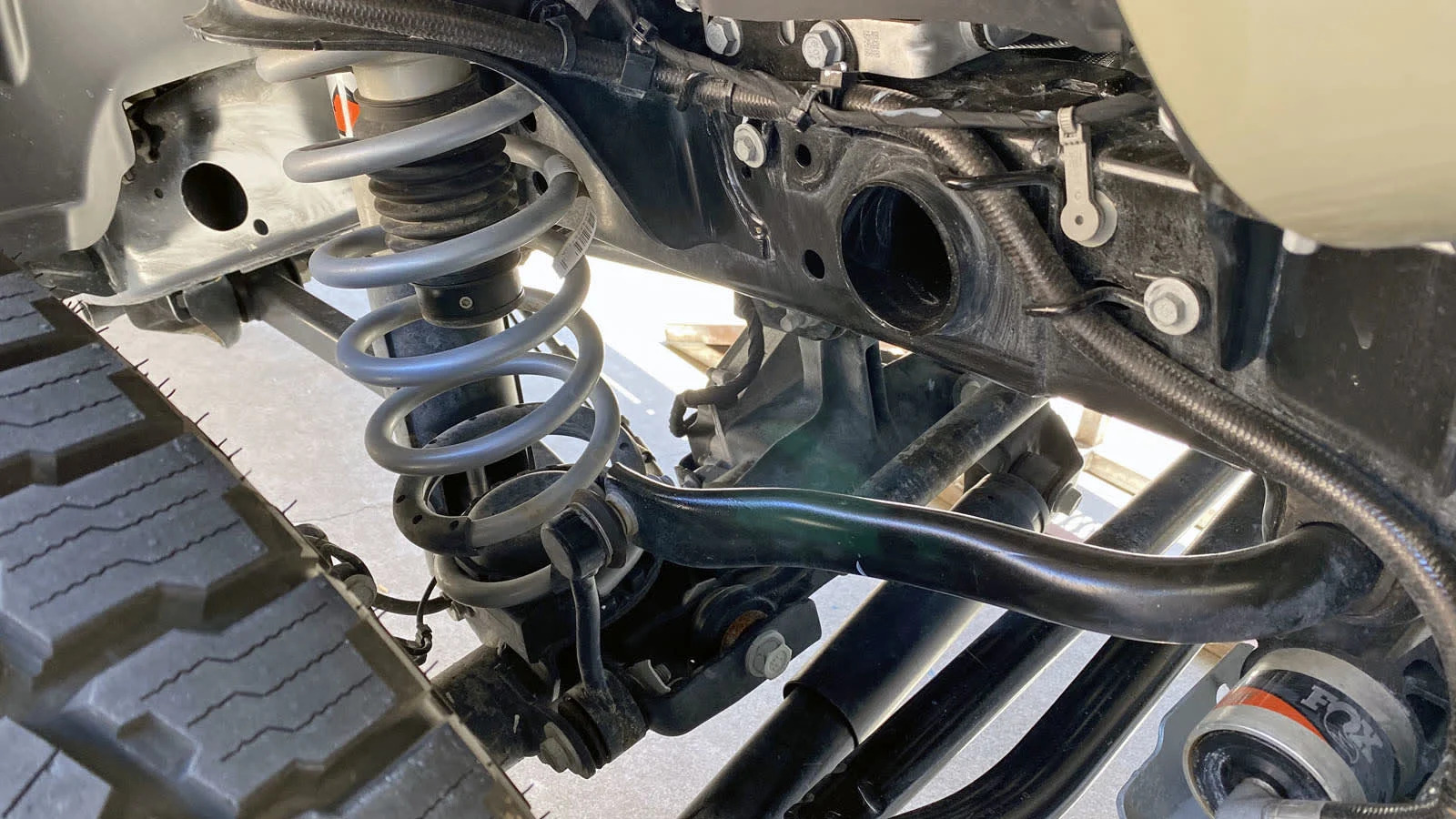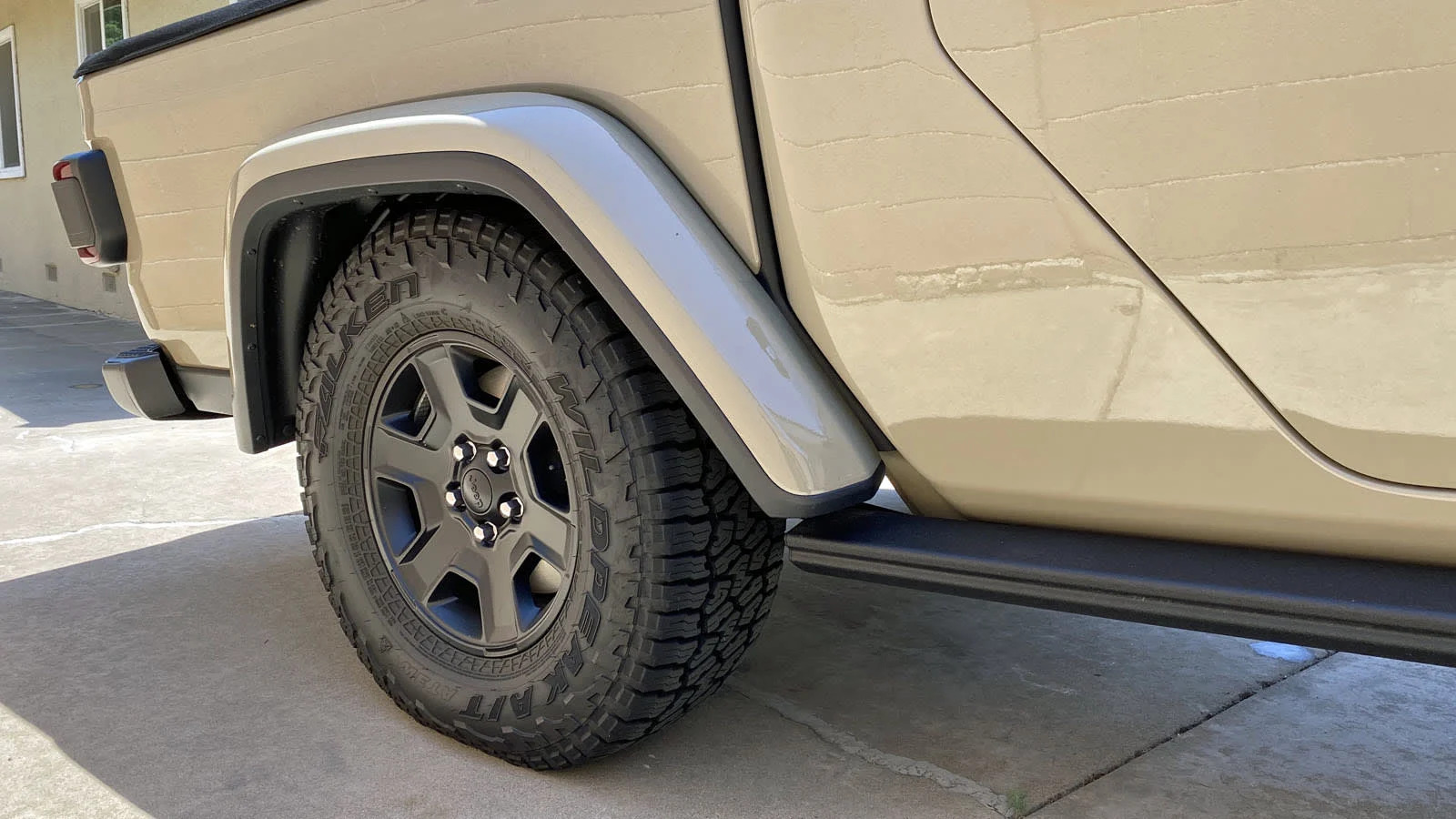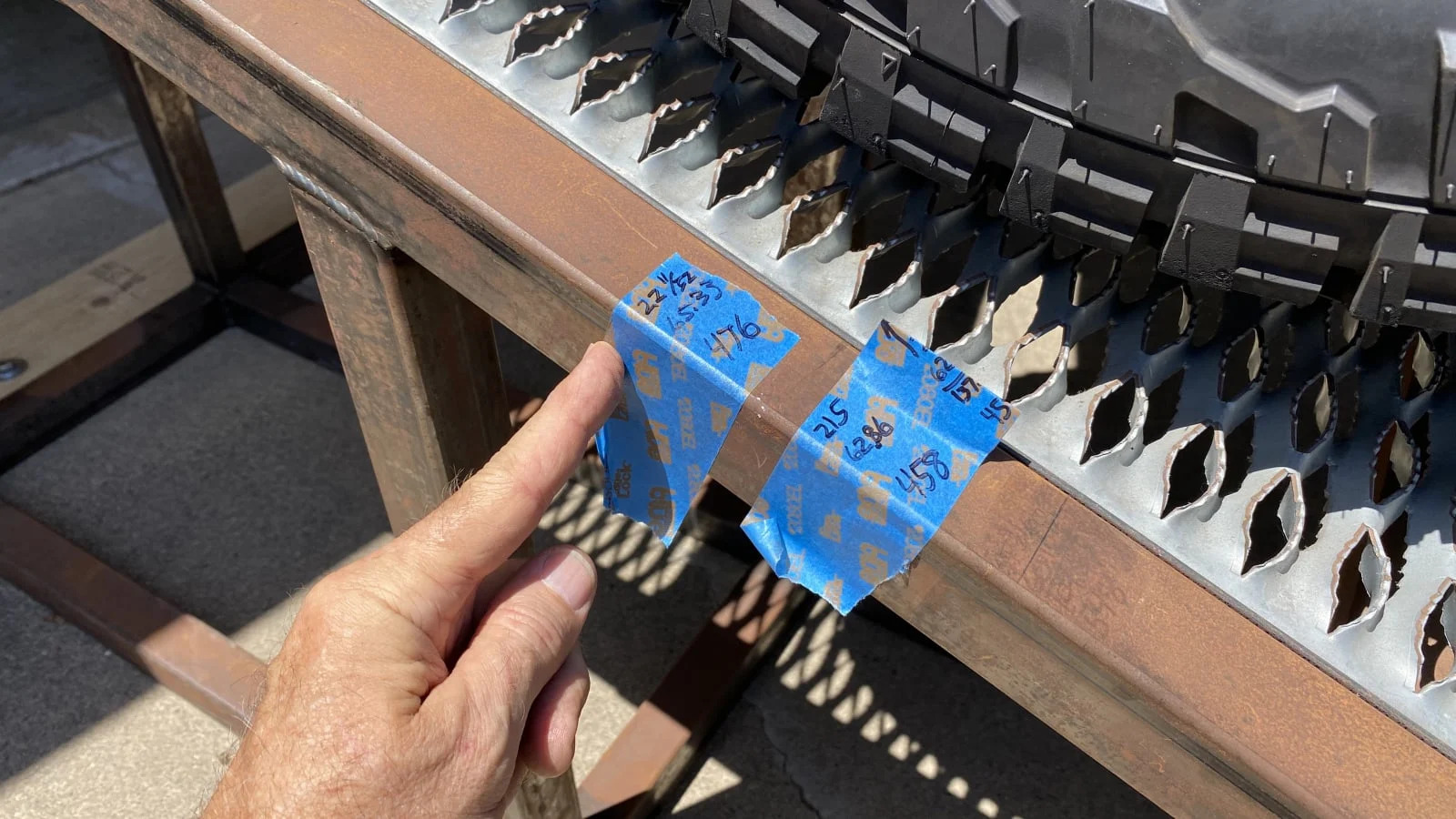I’ve been eager to get my hands on a new 2020 Jeep Gladiator Mojave ever since it was first announced. The specs are right up my alley: A 1-inch front lift to level the truck and give it more front compression travel, softer rear springs to allow the rear to be better synchronized with the front and more freely conform to terrain, beefier 2.5-inch Fox remote reservoir internal bypass shocks tuned to handle the inevitable pounding that comes with tackling desert terrain at speed, and hydraulic front bump stops to take the edge off the hardest hits.
But the trade-off for these high-dollar suspension bits is the elimination of some Gladiator Rubicon features. The Mojave only has a rear locker, and its low-range transfer case ratio is 2.72-to-1 instead of 4-to-1. I don’t think I’d miss either of those. I’m frankly more concerned about the absent steel rub rails behind the rear tire that protect the rear corner of the Gladiator’s bed because the desert has ditches, too. The last big missing piece is the electronically disconnectable front stabilizer bar. The Mojave’s is always connected.
I wondered how this last change and the Mojave’s unique suspension tuning might affect the overall flexibility of its suspension. The Mojave’s timing was perfect, because I had just acquired an RTI (Ramp Travel Index) ramp that’s designed to measure exactly that. And I had just run a Gladiator Rubicon up it as a test, so I had those numbers in hand.

The idea of an RTI ramp is simple. It creates an artificial but repeatable frame-twist situation that allows you to safely reach the point of maximum suspension flex and quantify that through a simple measurement. Numerical scores are based on a vehicle’s performance on a 20-degree ramp, an angle that was chosen some time ago and works well for stock vehicles.
Extremely modified vehicles can be tested on a steeper ramp (or by lifting a wheel with a forklift), but any number that results from that would have to be back-calculated to the 20-degree standard if the resulting numbers were to be compared to these.

But it’s not just a matter of how far up the ramp up can drive. The wheelbase factors into it. Why? A vehicle with an 8-foot wheelbase that drives 6 feet up the ramp has flexed a substantial amount in an extremely impressive way. Think of the front axle dangle angle it would take to do that. More radical than you see here, I can assure you. By contrast, an imaginary rig with a 100-foot wheelbase that makes it up 6 feet hasn’t accomplished much at all. That’d be like driving a Subaru onto a 2x4.
There is math involved, but the math is easy. And I’m calling the RTI score the Flex Index.
Flex Index = amount of ramp climb ÷ wheelbase x 1,000
A perfect score of 1,000 happens if the rear tire reaches the ramp before it lifts off the ground.

Let’s tour around the Gladiator Mojave at the point of maximum flex. This is the left front suspension. There’s plenty of daylight between the Fox hydraulic bump stop (yellow arrow) and it’s landing pad. This is fully usable travel if both front tires were compressing at the same time, but here we’re in a situation where this side is compressing while the other is extending.
The torsional stiffness of the stabilizer bar is defining the limit of deflection, along with the stiffness of the spring itself. A harder spring could always worsen things, but here the stabilizer bar is the limiting factor. That gap between the bump stop and its landing pad hints at the potential improvement that could be gained by disconnecting the stabilizer bar, as a Rubicon can.

The opposite is happening here on the right front. The axle is hanging below the vehicle, but not as much as it might if the stabilizer bar wasn’t working against it.

Here at the right rear, the suspension is fully compressed. There’s a stabilizer bar back here, too, but it’s much less influential than the one up front. It’s not disconnectable in a Rubicon or a Mojave, and there’d be little to gain if it was.
The important bit to notice here is the tire clearance. There’s plenty. A 35-inch tire (these Falkens are 33-inch tires) would probably have no trouble if you didn’t monkey with the offset and were careful not to choose ones that were too much wider. If you want to let your freak flag fly, the lower dark part of the fender flares can be removed.

The suspension is on full display here at the right rear. Nice-looking stuff, I must say.

All right, enough talk.
To get my number, I get out my T-square and project the hub center perpendicular to the ramp. The upper edges of the tape represent that point. The higher one is the Gladiator Mojave, the lower one is the Gladiator Rubicon with its stabilizer bar connected.
So the Mojave is slightly more flexible. But, and this is important, the only reason we can eyeball it like that is they both share the same 137.3-inch wheelbase. It’s two versions of the same vehicle.
My ramp doesn’t come to a perfect point, so I determine the amount of climb using trigonometry (feel free to skip ahead to the results in bold if the following brings back nightmares of high school math class). I measure the vertical height of the farthest point up the ramp and divide that by the sine of 20 degrees, our ramp angle. It’s an easier measurement, but there’s one extra math step.
Flex Index = vertical height of farthest point ÷ sin 20 ÷ wheelbase x 1,000
The Rubicon’s lift was 21.5 inches, which is 62.9 inches of climb
The Mojave’s lift measured 22 11/32 inches, which is 65.3 inches of climb - 2.4 inches more.
Dividing both by the wheelbase of 137.3 inches and multiplying by 1,000, we get:
Flex Index = 476 for the Mojave and 458 for the Rubicon with the bar connected. The Mojave’s differences add up to 18 points of improvement. Not much, but not nothing.
So why does the Mojave do better than the Rubicon in its normal state? It comes down to three factors, although I’m not certain if all of them help.
First, the rear springs are a bit softer, a change made so they’ll respond smoother over desert whoop-de-doos and washboard. The tow rating drops from 7,000 to 6,000 as a result. But they’re progressive, and it’s hard to know how they differ at this level of compression. Let’s set this aside.

You may have read that the Mojave’s track width is a half-inch wider than the Rubicon. It’s done by reducing the offset of the wheels, which pushes the tires outward to create more inside clearance for those bigger Fox shocks.
How? First, assume the axle’s maximum dangle angle is the same. Now, change the wheels so the tires are spread farther apart, as they are here. The hiked up wheel will be hiked up a little more, which means the vehicle can go farther up the ramp. I’ve measured this with my own Jeep before and after a major tire and wheel upgrade that involved huge offset and tire width changes.
These pictures show the wheel offset of the Rubicon and Mojave rims. The difference between them is 7.3 mm, so changing both sides together will create a track width increase of 14.6 mm. That works out to just over 9/16 inch, so Jeep seems to be underselling it by saying a half-inch. Still, this change isn’t meaningful enough to explain much of it.

The stabilizer bars themselves almost certainly hold the key. The Mojave’s rear one is 1 mm smaller – 20 mm instead of 21 mm. That may not sound like much, but the torsional stiffness of a stabilizer bar is proportional to its diameter raised to the fourth power. All else being equal, that drop of 1 mm represents an 18% drop in the stabilizer bar’s torsional stiffness. But the rear bar isn’t as crucial as the front one, so this probably isn’t it, either.
But there is a difference up front, even though both bars measure 32 mm in diameter. The key is how they look different. The Rubicon has the swaged look of a solid bar where it necks down for tire clearance, because it is. The Mojave has the squished look of a hollow tube, because it is.
That tube’s wall thickness is 5.1 mm, so if you do all the diameter math (to the fourth power) you get a decrease in torsional stiffness of about 20%.
That number assumes two things that might not be true: 1) the Rubicon’s sliding mechanism doesn’t negatively affect the bar’s overall stiffness in its connected state and 2) the bar’s material is the same despite one being hollow and the other solid.
This seems to explain it no matter how those turn out. And softer stabilizer bars would indeed help with high-speed desert performance and might represent another reason why the tow rating is a smidge lower.
All of this begs the question: What about the Gladiator Rubicon with the bar disconnected? My ramp tells us it destroys both of these. How does a Flex Index of 607 points grab you? Yes, pushing a button in a Rubicon is good for nearly 150 Flex Index points.
If all of this has soured you on the Mojave, it shouldn’t. The Gladiator isn’t the rock crawler that the Wrangler is, so there’s that. And you can add a stabilizer bar disconnect by installing special aftermarket links. I paid less than $100 for the ones I added to my own JK Wrangler Sport. It’s not as simple a pushing a button, and you have to be absolutely sure you reconnect them once you get back to pavement, but your Mojave can score better than 600 points, too, if you install a simple mod.
Contributing writer Dan Edmunds is a veteran automotive engineer and journalist. He worked as a vehicle development engineer for Toyota and Hyundai with an emphasis on chassis tuning, and was the director of vehicle testing at Edmunds.com (no relation) for 14 years. You can find all of his Suspension Deep Dives here on Autoblog.
Related Video:



Sign in to post
Please sign in to leave a comment.
Continue